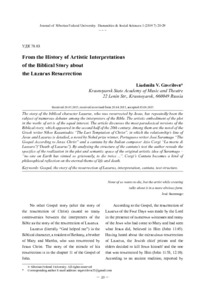From the History of Artistic Interpretations of the Biblical Story about the Lazarus Resurrection
Скачать файл:
URI (для ссылок/цитирований):
https://elib.sfu-kras.ru/handle/2311/10177Автор:
Gavrilova, Liudmila V.
Гаврилова, Л.В
Дата:
2014-01Аннотация:
The story of the biblical character Lazarus, who was resurrected by Jesus, has repeatedly been the
subject of numerous debates among the interpreters of the Bible. The artistic embodiment of the plot
in the works of art is of the equal interest. The article discusses the most paradoxical versions of the
Biblical story, which appeared in the second half of the 20th century. Among them are the novel of the
Greek writer Nikos Kazantzakis “The Last Temptation of Christ”, in which the relationship’s line of
Jesus and Lazarus is detailed, a novel by Nobel prize winner, Portuguese writer José Saramago “The
Gospel According to Jesus Christ” and a cantata by the Italian composer Azio Corgi “La morte di
Lazzaro”(“Death of Lazarus”). By analyzing the structure of the cantata’s text the author reveals the
specifics of the realization in the plot and semantic space of the original artistic idea of Saramago –
“no one on Earth has sinned so grievously, to die twice ...”. Corgi’s Cantata becomes a kind of
philosophical reflection on the eternal theme of life and death История о библейском персонаже Лазаре, воскрешенном Иисусом, неоднократно
становилась предметом многочисленных споров толкователей библии. Не меньший интерес
представляют и художественные воплощения сюжета в произведениях искусства. В статье
рассматриваются наиболее парадоксальные версии библейской истории, появившиеся во
второй половине ХХ века. Это роман греческого писателя Никоса Казандзакиса «Последнее
искушение Христа», где подробно выписана линия взаимоотношений Иисуса и Лазаря, роман
португальского писателя, нобелевского лауреата Жозе Сарамаго «Евангелие от Иисуса» и
кантата итальянского композитора Ацио Корги «La morte di Lazzaro» («Смерть Лазаря»).
На примере анализа текстовой структуры кантаты выявляется специфика реализации в
сюжетно-смысловом пространстве оригинальной художественной идеи Сарамаго – «никто
на свете не согрешил столь тяжко, чтобы умереть дважды…». Кантата Корги становится
своеобразным философским размышлением на вечную тему о жизни и смерти

